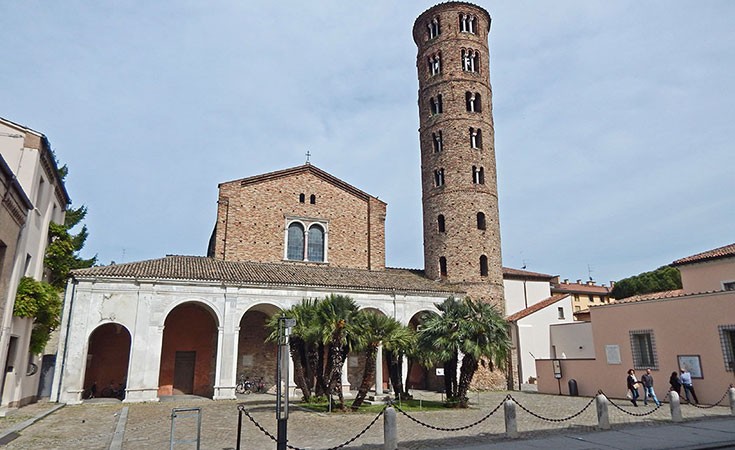Basilica of Sant Apollinare Nuovo was constructed according to the wish of King of Ostrogoths Theoderic, next to his palace. Today, it draws numerous tourists that admire the vivid mosaics that show the transition in the Christian art from the period of Theoderic trough the period of Eastern Roman Empire finishing with the period of the Catholic Church.
Basilica of Sant’ Apollinare Nuovo was constructed in 504AD by King of Ostrogoths Theoderic as his palace chapel. It was used by the Arian Christian cult (official religion of the kingdom) which had disagreements with the mainstream Christian religion and, for example, believed that the son of God did not always exist but was created by God, the father. Even this basilica with other seven sights found its place on UNESO World Heritage list.
In 561AD, after the Eastern Roman Empire occupied Ravenna, the church was re-consecrated, this time dedicated to Saint Martin who opened against the Arian church. According to tradition, in the 9th century, the relics of Saint Apollinaris were moved from Basilica Sant Apollinare in Classe, because of the constant threat of pirates that raided the coastal towns. This is why the new resting place was named Basilica Sant Apollinare Nuovo (in Italian nuovo means new).
The main attractions of the basilica are obviously the colorful and vivid mosaics that cover most of the interior walls. These mosaics show the transition from the Theoderic period and the later changes brought by the Eastern Roman Empire (Byzantine) during the rain of Justinian I. Additional changes to the mosaics were brought even later when the church fell under the Catholic Church dominion.
Interesting facts
- On both sides of the basilica large mosaics depict Jesus, on one as a young beardless man dressed as a Roman Emperor, while on the other side Jesus is depicted as an older man with beard. This evolution and process of growing up was important to the followers of the Arian Church.
- According to the legend, in 9th century Pope Gregory ordered mosaics in the church to be blackened, since supposedly, gold and vivid colors in mosaics distracted worshipers in their prayers.
- On the left wall of the basilica there is a mosaic that shows the scene from the Bible in which three kings (three wise man) brought gifts to Jesus. Above their figure there are inscribed names: Balthassar, Melchior and Caspar. It is believed that this is the earliest identification of three kings in Christian art.
Ticket Prices for Basilica of Sant Apollinare Nuovo in Ravenna
This ticket type is a cumulative ticket for the following attractions of Ravenna:
Basilica of San Vitale,
Mausoleum of Galla Placidia, Basilica of San Apollinare Nuovo, Neonian Baptistery and Archiepiscopal Museum.
Regular ticket price is 9.5 Euros (€) ($10.94).
Reduced ticket price is 8.5 Euros (€) ($9.79).
During the period from March 1
st to June 15
th the
additional 2€ charge applies for those that want to visit Mausoleum Galla Placidia.
Reduced price is reserved for students.
Free entrance: children under the age of 10 and handicapped individuals.
Before you decide to visit these attractions we advise you to check the prices on the official webpage of
Basilica Sant Apollinare Nuovo in Ravenna.
Working hours of Basilica Sant Apollinare Nuovo in Ravenna
Throughout the year all of the mentioned sights, included in the cumulative ticket, will be opened from 10:00 to 17:00h. Obviously, during the summer time the working hours will be a bit longer (from 09:00 to 19:00h) while during the winter period working hours will be shorter (from 10:00 to 17:00 or 09:30 to 17:00 depending on the sight)
In order to learn the exact working hours of individual sights (not the same for all attractions) we advise you to visit the official website of
Basilica Sant Apollineare Nuovo.
